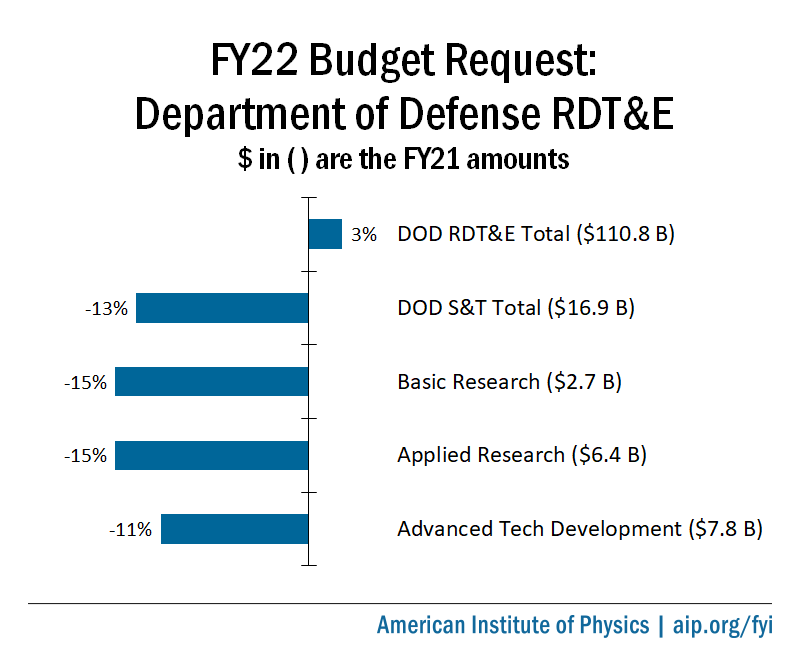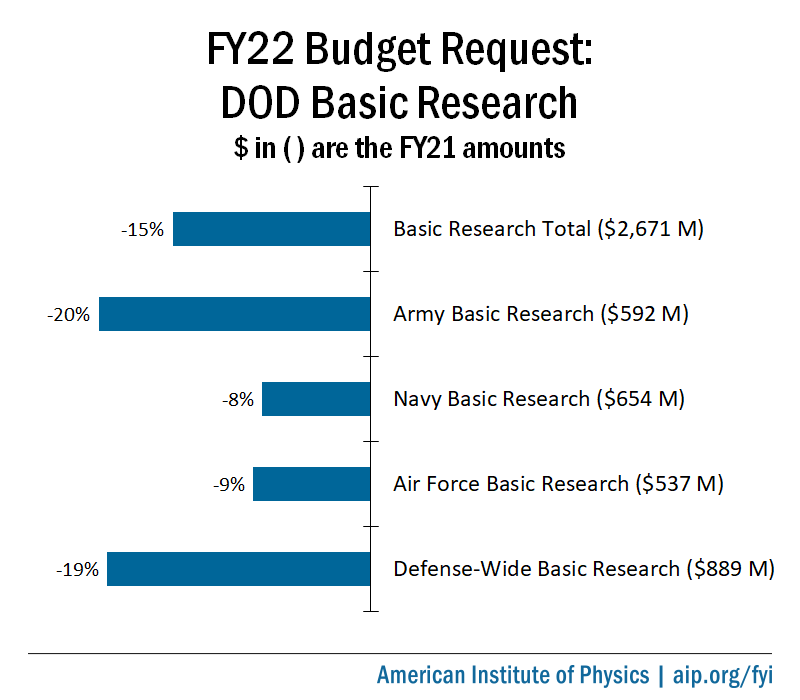
FY22 Budget Request: Department of Defense
The Biden administration is proposing to increase the budget for the Department of Defense’s Research, Development, Test, and Evaluation (RDT&E) programs by 3% to $114 billion for fiscal year 2022, pushing it past an already historically high level. However, within this total the administration proposes to cut the budget for DOD’s Science and Technology portfolio by 13% to $14.7 billion, rolling it back near the amount enacted for fiscal year 2018.
The portfolio comprises accounts funding basic research, applied research, and advanced technology development, which would each see double digit percentage cuts. Asked about the cuts during a hearing this week, Defense Secretary Lloyd Austin noted the budget request for these activities is higher than last year, when DOD sought $14.0 billion for them. In recent years, Congress has consistently appropriated more than DOD has requested for early-stage research programs.
Among its later-stage RDT&E programs, DOD continues to prioritize efforts focused on what it calls “advanced capability enhancers,” which include microelectronics, hypersonics, artificial intelligence, and 5G telecommunications.
Selected figures from the request are available in FYI’s Federal Science Budget Tracker and highlights are summarized below.


Basic research and STEM education
Total funding for basic research would fall 15% to $2.28 billion under the request, with cuts distributed across the military service branches and defense agencies.
University Research Initiatives. Across the Army, Navy, and Air Force, funding for University Research Initiatives would drop 21% to $347 million. These accounts fund the Multidisciplinary University Research Initiatives (MURI) program, the Defense University Research Instrumentation Program (DURIP), and the National Defense Science and Engineering Graduate Fellowships, among other activities.
Defense Research Sciences. Funding for Defense Research Sciences across the three service branches and the Defense Advanced Research Projects Agency would drop 9% to $1.51 billion. These accounts support a variety of intramural and extramural basic research projects.
DARPA. Funding for the Defense Research Sciences account at DARPA would drop 17% to $396 million, reversing a large increase Congress provided last year. DOD does however propose to increase DARPA’s basic medical research program by 41% to $76 million and to keep the agency’s overall budget steady at $3.53 billion. DOD requests increases for DARPA’s work in advanced electronics and sensor technologies while paring back aerospace and space technology programs.
Social science research. DOD does not repeat its proposal from last year to disband the Minerva Research Initiative, which supports academic social science research. However, DOD only requests $4 million for the initiative through its Basic Research Office, down from the $17 million Congress provided last year.
National Defense Education Program. DOD proposes to cut funding for the National Defense Education Program by $25 million to $112 million. The program supports a variety of STEM education activities, including the SMART scholarships-for-service, the Manufacturing Engineering Education Program (MEEP), and outreach activities. DOD requests no funds for MEEP, which previously was funded through congressional direction and in 2020 issued $42 million to nine awardees. Meanwhile, DOD proposes to increase funding for SMART scholarships from $77 million to $89 million, which it states would increase the annual number of awards made from about 300 to 400.
Minority Serving Institutions. DOD proposes to cut funding for a program that supports research and education activities at Historically Black Colleges and Universities and other Minority Serving Institutions from $81 million to $31 million. Congress has funded the program well above the requested levels in recent years, in part to create new research centers focused on aerospace engineering, artificial intelligence, quantum sensing, and advanced communications.
Defense EPSCoR. DOD repeats its request from last year to discontinue funding for the Defense Established Program to Stimulate Competitive Research, which Congress recreated in fiscal year 2019 to support projects in states that have historically received a low share of DOD research funding. Congress rejected the proposal last year, instead providing the program $17 million. DOD previously operated an EPSCoR program from 1991 until 2010, when it was disbanded.
Selected technology initiatives

An engineering facility at Hill Air Force Base, Utah, which is serving as a testbed for incorporating 5G technologies into radar applications.
(Image credit – Todd Cromar / U.S. Air Force)
5G telecommunications. Funding for the Next Generation Information Communications Technology program would drop 15% to $375 million under the request. DOD attributes the cut to the completion of site construction for experiments that are demonstrating 5G uses that have both commercial and military applications. Last year, DOD selected five military installations to serve as testing hubs for 5G technologies. Within the program, DOD proposes to ramp up funds for experimenting with operations in “congested/contested spectrum” environments from $198 million to $284 million.
DOD also requests a $5 million increase to $23 million for the separate Beyond 5G program , which aims to help the U.S. “regain leadership in emerging wireless technology standards.” DOD is conducting the program in coordination with the National Institute of Standards and Technology and the National Science Foundation, which each have prioritized advanced telecommunications research in their respective budget requests . The three agencies have also teamed up through NSF’s new Resilient and Intelligent NextG Systems (RINGS) program.
Microelectronics. DOD requests $2.3 billion for developing next generation microelectronics, investing in domestic production capabilities, and purchasing legacy chips to sustain existing weapons systems. Within the Air Force’s procurement budget, DOD seeks $885 million in new funds to acquire “critical microelectronic components in advance of commercial manufacturing line closures,” stating the purchases are time sensitive and that the details are classified. DOD also proposes to significantly expand purchases of radiation hardened microelectronics using the Defense Production Act.
As part of the RDT&E budget, DOD requests $623 million for its Trusted and Assured Microelectronics programs , a 2% increase. Within the total, DOD seeks a $39 million increase to $104 million for an effort to develop radiation hardened microelectronics in partnership with NASA and the Department of Energy.
Artificial intelligence. DOD states it now has more than 600 discrete “AI efforts” underway across the department and requests a total of $874 million to support them. Among the specific initiatives, DOD requests $14 million for a new research program at MIT’s Lincoln Laboratory that would create a “standard development toolset to democratize AI development in the department” and would conduct a “challenge project” to demonstrate ways of accelerating scientific discovery using AI.
Quantum information science. DOD does not report a total budget for quantum information science and technology. Among the proposed new activities this year is a $29 million program that would accelerate work on a next generation atomic clock and facilitate researcher access to quantum computing capabilities in the private sector, pursuant to a provision in the National Defense Authorization Act for Fiscal Year 2021.
Mobile nuclear reactor. DOD requests $60 million for Project Pele, an effort to design a one to five megawatt transportable nuclear reactor. This is the first year DOD has specifically requested money for the project, which was first funded through congressional direction in fiscal year 2020. Last year, Congress appropriated $70 million for the project and $10 million for development of the meltdown-resistant TRISO fuel the reactor would employ. In March, DOD selected two projects to proceed toward a final design.
Space Force. DOD requests $11.3 billion for RDT&E programs of the Space Force, a 7% increase. Among its flagship initiatives is the Next Generation Overhead Persistent Infrared (Next-Gen OPIR) program , which is building a successor to the current space-based constellation of missile warning satellites. DOD proposes to ramp up the program’s budget from $2.32 billion to $2.45 billion as it works to field the first geostationary satellite in the constellation no later than fiscal year 2025. Congress considers the project a test case for using special authorities to accelerate major technology procurements.
National Security Innovation Capital. In fiscal year 2021, Congress provided an initial appropriation of $15 million for National Security Innovation Capital , a program that invests in dual-use hardware startups as a counterweight to venture capital from rival nations. DOD requests $5 million for the program for fiscal year 2022, stating it would continue funding startups that have capabilities in “autonomy, communications, power, sensors, and space.”



